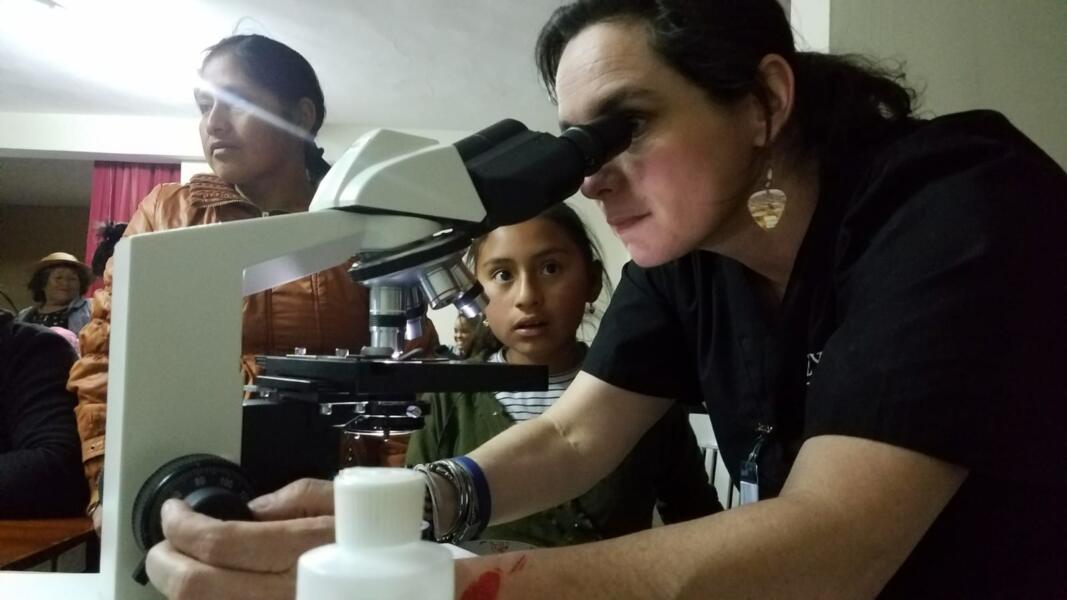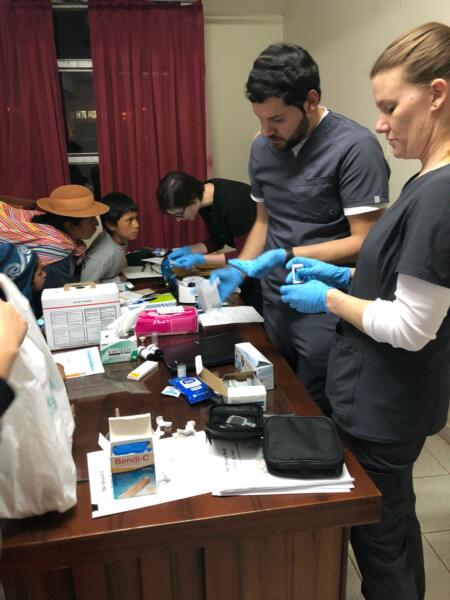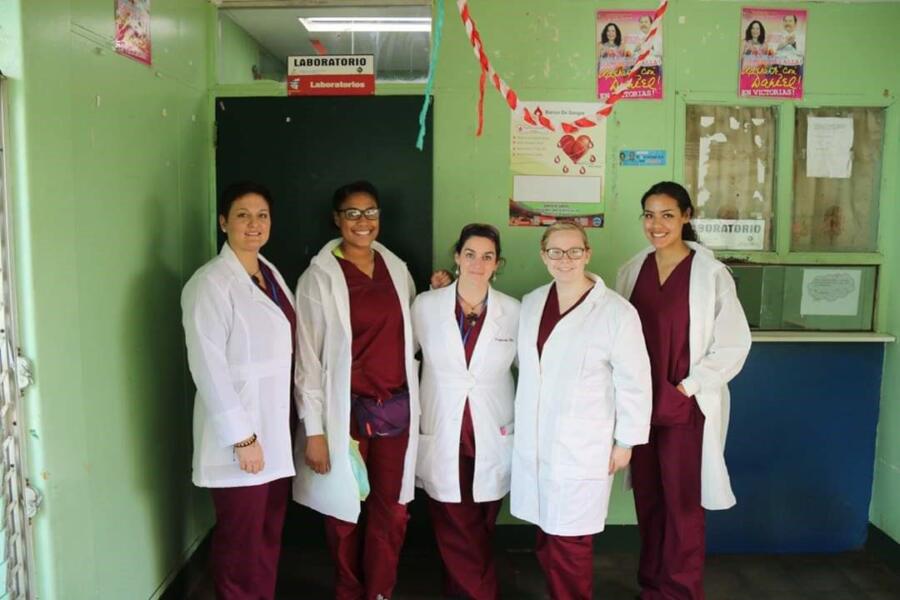Joanna Ellis, MS, MLS(ASCP)CM, CHWI
 |
| Future Peruvian laboratory professional with Professor Ellis at the microscope. |
 |
| Francisco James and Jamie Vreeland perform anemia screening in Aco, Peru. |
 |
| From left: Jennifer Pemp, Ashley Wells, Professor Ellis, Ashleigh Graham, and Idahlia Bland in Nicaragua. |
Clinical Laboratory Science (CLS) professionals are underrepresented in study abroad (SA) programs, public health campaigns, and medical volunteer trips. As a clinical assistant professor of CLS at Texas State (TxSt) University, I set out to change that by creating a culturally-sensitive and ethically-responsible SA program for our students.
I helped create the first interprofessional service-learning SA program in the nation that included CLS students. I collaborated with faculty from the TxSt St. David’s School of Nursing, Respiratory Care, and Mass Communication programs to add interprofessional education to the existing nursing SA program in Nicaragua.
When I began exploring this opportunity, I consulted a lab professional that has extensive experience with health clinic labs in Haiti. I read many international volunteering resources, one of my favorites being When Healthcare Hurts, by Greg Seager. I learned how good intentions often fail to achieve positive outcomes in service abroad trips. Prior to the Nicaragua trip in 2017, I gave lectures on perceptions of poverty, monochronic vs polychronic societies, photography ethics, individualistic vs collectivist societies, health clinic best practices, and other topics to optimize positive results in the local community.
Interprofessional Study Abroad in Nicaragua
In Nicaragua, we conducted house visits where we collected public health information for the household and invited the families to our clinics. We enjoyed the learning experience, but due to the challenges of bringing lab equipment into Nicaragua, the CLS students were only able to conduct urine dipstick and pregnancy tests in these pop-up clinics.
We visited two Nicaraguan labs—one rural and one urban public hospital lab. In the rural lab, there were no computers. They washed and reused blood slides, pipette tips, and gloves. They performed red and white cell counts on a hemocytometer: tap, tap, tapping ALL DAY LONG. Patients submitted stool specimens in matchboxes.
The lab manager was an unflappable woman who described every step of their spectrophotometer chemistry tests and her unusual method for never missing “hard sticks.” She let us observe as she performed a painful skin scraping on a woman with a history of leishmaniosis.
The urban hospital lab had computer systems and automation much like a small rural lab in Texas might have. In the Microbiology Department, they had much of the same media that we use, but not an identification system. We noted that they had blood culture bottles, but not the detection system. They incubated the bottles and did a gram stain every few hours to detect positives.
At our evening debriefs, the four CLS students and I relayed all the interesting experiences we had in the labs and discussed what the healthcare team should know about lab science. One CLS student even taught a local physician and the nursing students about the potential to detect advanced testicular cancer with a pregnancy test. We created an interprofessional team that achieved the goal of learning the expertise of each of the different health professions, but there were opportunities for improvement in creating a program that effectively and sustainably promoted public health, continuity of care, and empowerment for the community.
The Path to Improvement
I was determined to learn how to achieve a truly mutually-beneficial SA program. I became a certified community health worker instructor (CHWI) through the Texas Department of State Health Services and earned a Certificate in Sustainable Community Development from Colorado State University. I learned more tips on how to avoid competing with local practitioners or businesses and creating dependency through paternalistic practices. I looked for a service provider with a sustained, year-round presence in their communities and a willingness to implement best practice procedures in all our events.
The Foundation for International Medical Relief of Children (FIMRC) fit the bill. In collaboration with FIMRC and following the guidance of The World Health Organization to promote education before medication, I worked with local physicians to determine appropriate lab testing and develop culturally-appropriate educational materials for a “Community Health Screening and Education through Laboratory Science Workshop” (CHS&E).
CLS Study Abroad in Peru
In June of 2018, I completed the first CLS-specific SA program in the 42-year history of the Texas State CLS program. Five senior-level students, my husband, and I spent two weeks learning about the healthcare system, lab services, and culture of Peru. We helped medical students detach skin from a cadaver, observed surgeries, and toured private and hospital labs in Huancayo, Peru.
The Carrion Hospital lab is enormous and quite advanced. The small private lab had compact CBC and Chem7 analyzers they were proud to demonstrate. We worked in an existing rural clinic to provide screening tests that the tiny lab could not offer routinely. We screened over 150 people. Using a hand-crank centrifuge, we detected two cases of syphilis, over 25 UTIs, and many anemic patients! We gave all abnormal results to a local physician for follow-up and treatment.
During our CHS&E through lab science workshop, we used the Lab-in-a-Suitcase® to screen families for anemia and diabetes. We showed them Giardia in the microscope and discussed hygiene. Everyone loved the microscope!
We had interactive educational and craft stations where we demonstrated the plasma and cellular components of their microhematocrit, how sugar gets in urine, the effectiveness of their hand-hygiene, and some tests we use in diagnostics. They learned about the biological impact of their dietary choices in new and creative ways. As a bonus, they learned about the field of CLS!
I spoke about my novel CHS&E approach at the African Society for Laboratory Medicine 2018 Conference in Abuja, Nigeria. The workshop was lauded as “inspirational” and a “brilliant blend of clinical and public health services.” It’s time we take our CLS skills up, up, and abroad!
Joanna Ellis is clinical assistant professor and clinical coordinator at Texas State University in San Marcos, Texas.
